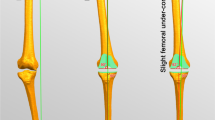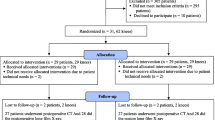Abstract
Purpose
Restoration of neutral alignment is considered key in total knee arthroplasty (TKA). However, this may be undesirable and can result in medial soft-tissue over-release in patients with varus knee and lateral femoral bowing. This study aimed to determine whether individualized intentional varus distal femoral cutting yielded satisfactory clinical and radiological outcomes.
Methods
A total of 77 patients (91 knees) with varus knee (hip–knee–ankle axis ≥ 10°) and lateral femoral bowing > 5° underwent navigation-assisted primary TKA using individualized intentional varus distal femoral cutting. Knee Society scores, Western Ontario and McMaster Universities scores, and radiographs for limb alignment, implant alignment, and aseptic loosening were evaluated. Subgroup analyses were performed according to the limb alignment and coronal femoral component alignment (0° ± 3° vs. varus of > 3°).
Results
All clinical outcomes significantly improved at the final follow-up (p < 0.05 in all). The mechanical axis angle changed from 13.1° ± 2.7° to 2.8° ± 1.5°. The coronal femoral component angle at the final follow-up was 2.8° ± 1.3°. Radiolucent lines were observed in 6 cases (6.6%) and were less than 2 mm in all cases without progression. In subgroup analyses, no significant differences were observed in clinical outcomes (n.s. in all) and in the incidence of radiolucent lines (n.s. in limb alignment, n.s. in coronal femoral component alignment).
Conclusions
Individualized intentional varus distal femoral cutting yielded favorable clinical outcomes without complications at 5-year follow-up. Slight under-correction using intentional varus distal femoral cutting could be a viable option in patients with varus knee and lateral femoral bowing during navigation-assisted TKA.
Level of evidence
IV.





Similar content being viewed by others
References
Argenson J-NA, Parratte S, Ashour A, Saintmard B, Aubaniac J-M (2012) The outcome of rotating-platform total knee arthroplasty with cement at a minimum of 10 years of follow-up. J Bone Joint Surg Am 94:638–644
Bellemans J, Colyn W, Vandenneucker H, Victor J (2012) The Chitranjan Ranawat Award: is neutral mechanical alignment normal for all patients?: the concept of constitutional varus. Clin Orthop Relat Res 470:45–53
Bonner TJ, Eardley WG, Patterson P, Gregg PJ (2011) The effect of post-operative mechanical axis alignment on the survival of primary total knee replacements after a follow-up of 15 years. J Bone Joint Surg Br 93:1217–1222
Bourne RB, Chesworth BM, Davis AM, Mahomed NN, Charron KD (2010) Patient satisfaction after total knee arthroplasty: who is satisfied and who is not? Clin Orthop Relat Res 468:57–63
Cheng T, Zhao S, Peng X, Zhang X (2012) Does computer-assisted surgery improve postoperative leg alignment and implant positioning following total knee arthroplasty? A meta-analysis of randomized controlled trials? Knee Surg Sports Traumatol Arthrosc 20:1307–1322
Choong PF, Dowsey MM, Stoney JD (2009) Does accurate anatomical alignment result in better function and quality of life? Comparing conventional and computer-assisted total knee arthroplasty. J Arthroplasty 24:560–569
Cooke TD, Sled EA, Scudamore RA (2007) Frontal plane knee alignment: a call for standardized measurement. J Rheumatol 34:1796–1801
Crowninshield RD, Rosenberg AG, Sporer SM (2006) Changing demographics of patients with total joint replacement. Clin Orthop Relat Res 443:266–272
Delport H, Labey L, Innocenti B, De Corte R, Vander Sloten J, Bellemans J (2015) Restoration of constitutional alignment in TKA leads to more physiological strains in the collateral ligaments. Knee Surg Sports Traumatol Arthrosc 23:2159–2169
Delport H, Labey L, Innocenti B, De Corte R, Vander Sloten J, Bellemans J (2015) Restoration of constitutional alignment in TKA leads to more physiological strains in the collateral ligaments. Knee Surg Sports Traumatol Arthrosc 23:2159–2169
Herschmiller T, Grosso MJ, Cunn GJ, Murtaugh TS, Gardner TR, Geller JA (2018) Step-wise medial collateral ligament needle puncturing in extension leads to a safe and predictable reduction in medial compartment pressure during TKA. Knee Surg Sports Traumatol Arthrosc 26:1759–1766
Hetaimish BM, Khan MM, Simunovic N, Al-Harbi HH, Bhandari M, Zalzal PK (2012) Meta-analysis of navigation vs conventional total knee arthroplasty. J Arthroplasty 27:1177–1182
Heyse TJ, Decking R, Davis J, Boettner F, Laskin RS (2009) Varus gonarthrosis predisposes to varus malalignment in TKA. HSS J 5:143–148
Howell SM, Papadopoulos S, Kuznik K, Ghaly LR, Hull ML (2015) Does varus alignment adversely affect implant survival and function 6 years after kinematically aligned total knee arthroplasty? Int Orthop 39:2117–2124
Hsu R, Himeno S, Coventry MB, Chao E (1990) Normal axial alignment of the lower extremity and load-bearing distribution at the knee. Clin Orthop Relat Res 255:215–227
Innocenti B, Bellemans J, Catani F (2016) Deviations from optimal alignment in TKA: is there a biomechanical difference between femoral or tibial component alignment? J Arthroplasty 31:295–301
Kim J-M, Hong S-H, Lee B-S, Kim D-E, Kim K-A, Bin S-I (2015) Femoral shaft bowing in the coronal plane has more significant effect on the coronal alignment of TKA than proximal or distal variations of femoral shape. Knee Surg Sports Traumatol Arthrosc 23:1936–1942
Ko Y-B, Jang E-C, Park S-M, Kim SH, Kwak Y-H, Lee H-J (2015) No difference in clinical and radiologic outcomes after total knee arthroplasty with a new ultra-congruent mobile bearing system and rotating platform mobile bearing systems after minimum 5-year follow-up. J Arthroplasty 30:379–383
Kwak DS, In Y, Kim TK, Cho HS, Koh IJ (2016) The pie-crusting technique using a blade knife for medial collateral ligament release is unreliable in varus total knee arthroplasty. Knee Surg Sports Traumatol Arthrosc 24:188–194
Lampart M, Behrend H, Moser LB, Hirschmann MT (2018) Due to great variability fixed HKS angle for alignment of the distal cut leads to a significant error in coronal TKA orientation. Knee Surg Sports Traumatol Arthrosc 27:1434–1441
Lasam MPG, Lee KJ, Chang CB, Kang YG, Kim TK (2013) Femoral lateral bowing and varus condylar orientation are prevalent and affect axial alignment of TKA in Koreans. Clin Orthop Relat Res 471:1472–1483
Lee C-Y, Lin S-J, Kuo L-T, Peng K-T, Huang K-C, Huang T-W, Lee MS, Hsu RW-W, Shen W-J (2014) The benefits of computer-assisted total knee arthroplasty on coronal alignment with marked femoral bowing in Asian patients. J Orthop Surg Res 9:122
Lee YS, Howell SM, Won YY, Lee OS, Lee SH, Vahedi H, Teo SH (2017) Kinematic alignment is a possible alternative to mechanical alignment in total knee arthroplasty. Knee Surg Sports Traumatol Arthrosc 25:3467–3479
Longstaff LM, Sloan K, Stamp N, Scaddan M, Beaver R (2009) Good alignment after total knee arthroplasty leads to faster rehabilitation and better function. J Arthroplasty 24:570–578
Maderbacher G, Baier C, Benditz A, Wagner F, Greimel F, Grifka J, Keshmiri A (2017) Presence of rotational errors in long leg radiographs after total knee arthroplasty and impact on measured lower limb and component alignment. Int Orthop 41:1553–1560
Magnussen RA, Weppe F, Demey G, Servien E, Lustig S (2011) Residual varus alignment does not compromise results of TKAs in patients with preoperative varus. Clin Orthop Relat Res 469:3443–3450
Matziolis G, Adam J, Perka C (2010) Varus malalignment has no influence on clinical outcome in midterm follow-up after total knee replacement. Arch Orthop Trauma Surg 130:1487–1491
Mugnai R, Zambianchi F, Digennaro V, Marcovigi A, Tarallo L, Del Giovane C, Catani F (2016) Clinical outcome is not affected by total knee arthroplasty alignment. Knee Surg Sports Traumatol Arthrosc 24:3339–3345
Mullaji AB, Marawar SV, Mittal V (2009) A comparison of coronal plane axial femoral relationships in Asian patients with varus osteoarthritic knees and healthy knees. J Arthroplasty 24:861–867
Nagamine R, Miura H, Bravo CV, Urabe K, Matsuda S, Miyanishi K, Hirata G, Iwamoto Y (2000) Anatomic variations should be considered in total knee arthroplasty. J Orthop Sci 5:232–237
Parratte S, Pagnano MW, Trousdale RT, Berry DJ (2010) Effect of postoperative mechanical axis alignment on the fifteen-year survival of modern, cemented total knee replacements. J Bone Joint Surg Am 92:2143–2149
Parsch D, Kruger M, Moser MT, Geiger F (2009) Follow-up of 11–16 years after modular fixed-bearing TKA. Int Orthop 33:431–435
Slevin O, Hirschmann A, Schiapparelli FF, Amsler F, Huegli RW, Hirschmann MT (2018) Neutral alignment leads to higher knee society scores after total knee arthroplasty in preoperatively non-varus patients: a prospective clinical study using 3D-CT. Knee Surg Sports Traumatol Arthrosc 26:1602–1609
Tang W, Zhu Y, Chiu K (2000) Axial alignment of the lower extremity in Chinese adults. J Bone Joint Surg Am 82:1603–1608
Vanlommel L, Vanlommel J, Claes S, Bellemans J (2013) Slight undercorrection following total knee arthroplasty results in superior clinical outcomes in varus knees. Knee Surg Sports Traumatol Arthrosc 21:2325–2330
Yau W, Chiu K, Tang W, Ng T (2007) Coronal bowing of the femur and tibia in Chinese: its incidence and effects on total knee arthroplasty planning. J Orthop Surg 15:32–36
Funding
No funding was received for this study.
Author information
Authors and Affiliations
Corresponding author
Ethics declarations
Conflict of interest
There are no conflicts of interest to declare for any authors.
Ethical approval
All procedure performed in the study involving humans participants were in accordance with the ethical standards of the institutional research committee and with the 1964 Helsinki declaration and its later amendments or comparable ethical standards. The study was approved by the Institutional Review Boards of Chung-Ang University Hospital (IRB no. 1600-003-253).
Informed consent
Informed consent was obtained from all individual participants in the study.
Additional information
Publisher's Note
Springer Nature remains neutral with regard to jurisdictional claims in published maps and institutional affiliations.
Rights and permissions
About this article
Cite this article
Lee, HJ., Lim, JW., Lee, DH. et al. Slight under-correction using individualized intentional varus femoral cutting leads to favorable outcomes in patients with lateral femoral bowing and varus knee. Knee Surg Sports Traumatol Arthrosc 28, 1579–1586 (2020). https://doi.org/10.1007/s00167-019-05577-1
Received:
Accepted:
Published:
Issue Date:
DOI: https://doi.org/10.1007/s00167-019-05577-1




